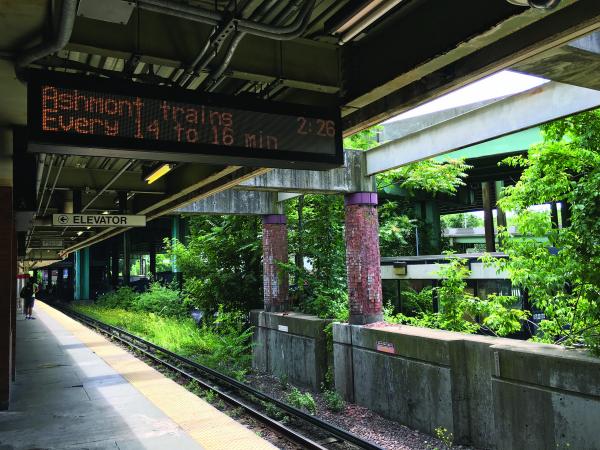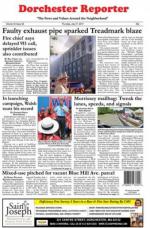July 18, 2019

The Ashmont platform at JFK-UMass station this week. Jennifer Smith photo
JFK/UMass station sits at the joint of Dorchester and South Boston, with connected train branches and adjoining roadways stretching out like spokes on a wheel around it. The critical entryway into a stretch of Boston gearing up for a building boom is primed for an overhaul, local stakeholders say.
Built as rapid transit stop in 1927, then “Columbia Station” was part of the Old Colony Railroad line. Under MBTA control, the once “Columbia-Dorchester Line” heading down to Ashmont became the Red Line in 1965 and the station was renamed for the UMass Boston campus and John F. Kennedy Library some 17 years later.
Braintree trains did not stop at the JFK/UMass station until a 1988 renovation included the construction of a new platform dedicated to the other Red Line route. The MBTA built a commuter rail platform in Spring 2001.
“The last time I looked it was joyless and dirty, much of the floor square footage was a large trip hazard lacking in sufficient lighting,” said Michael McColgan, an executive board member of the nearby John W. McCormack Civic Association. “I believe the whole station needs a rehab or modernization… It’s a station that has a huge workload. It’s more than a neighborhood station. It’s a station in a vast center of educational institutions and museums. It was state of the art 50 years ago when the neighborhood was just a neighborhood.”
JFK/UMass has seen some improvements in recent years. An array of security cameras were installed in the early 2010s, a Columbia Junction signal replacement project that began in 2012 and ended in 2014, and the station was part of a $25 million system-wide “Brightening Project” in April. But there have not been any major construction improvements in decades.
At the tip of the line, a newly reconstructed Ashmont station was ushered open in 2015. “All of the stations on the Ashmont branch were completely rebuilt between 12 and 14 years ago, making them the newest in the subway system (with one or two exceptions),” wrote MBTA spokesman Joe Pesaturo in an email.
“The stations aren’t that old, they’re from the 90s,” State Rep. Dan Hunt noted, “So it’s not just new investment but the existing deferred maintenance, making sure the investments that were made previously are protected. In a major storm event, Fields Corner station is raining inside.”
On June 10, the derailment of a southbound Braintree train—which slammed into signal bungalows and crippled the Red Line’s movements and rippled across Greater Boston’s transit system — once again highlighted the centrality of the station. Just this Monday, the MBTA announced that crews have rebuilt three signal bungalows and built one additional bungalow for communications and power support.
“As of Friday, 21 of 29 signals and 11 of 19 switches are once again being remotely controlled by dispatchers at our Operations Control Center (OCC),” the MBTA reported. “The number of trains we can move through the area is increasing. Crews are working around-the-clock on the remaining signals and switches that were most critically damaged. Some manual operation of signals and switches will continue in the coming weeks.”
Transit officials estimated that reduced service levels will last until Labor Day. The normal standard of service would resume until accelerated signal rehabs and new Red Line trains bring anticipated improvements in just under three years.
Some improvements to the line are already in the pipeline. The MassDOT Board of Directors and the MBTA Fiscal Management and Control Board voted June 18 to approve a five-year $18.3 billion MassDOT and MBTA Capital Investment Plan for Fiscal Years 2020-2024. It includes a number of items Gov. Charlie Baker said will support “the ongoing transformation of the Red and Orange Lines.”
New trains and full signal replacements are included in the $1.58 billion plan for Red Line/Orange Line improvements, and the $875 million for additional capital investments in the Red Line includes some $640.6 million for improvements including bridges, track, signals, accessibility improvements, wayfinding, and stations.
“There is funding in the CIP for roof replacement at JFK/UMass,” Pesaturo wrote. “General capital renewal work such as repairs to stairs and platform edges will occur at stations along the Ashmont branch. All of the customers who use the Ashmont branch stations will benefit from the hundreds of millions of dollars being spent on Red Line improvements.”
Pesaturo notes that “the combination of new trains and a modernized signal system will lead to both increased capacity and more frequent service.”
But, looking beyond the near term fixes, is a new-and-improved JFK/UMass station — perhaps with a housing or mixed-use development created in tandem—on the horizon? It’s a topic that has been on the minds of nearby residents and institutions for much of the last decade. In 2011, a city-led Columbia Point Master Plan included the station in its planning scope and envisioned height and density near the JFK stop, but not on top of it.
“There are no imminent plans for a development at that site,” Pesaturo said at the time.
City Councillor Frank Baker is one of several local leaders who see a need for a modernized station.
“I think we need one,” said City Councillor Frank Baker, whose district includes the JFK-UMass station. “Going into the future the number of people going on the train will go up. Now we’re beginning to be overburdened. We need a new station, we need [Kosciusko] Circle fixed, we need Morrissey [Boulevard reconstructed], or we in Savin Hill and down in Neponset are going to be stuck on the other side of Dot.”
The station is integral to a wave of new development coming to the area, especially with major mixed-use projects like The BEAT on Morrissey Boulevard (at the former Boston Globe site) and the massive Bayside redevelopment across the street.
“The city is growing in this direction,” said Todd Fremont-Smith, senior vice president of development at Nordblom Co. “It can’t really grow to the north or east, so it really is growing in this direction and you’ve got millions of square feet of development centered around this station, and the reason we and others are investing in this neighborhood is because of that station. It is the catalyst… and it’s critically important to The BEAT, to Center Court Partners, to the JFK Library, to Bayside Expo, to all these projects that are proposed around Columbia Point. They are [siting here] because of the Red Line.”
JFK/UMass station – which Fremont-Smith describes as a “baby South Station” – has a unique structure, with the Braintree and Ashmont lines passing in and out on along two separate platforms on their way to and from Alewife. Just outside the subway platforms, a separate commuter rail platform lets riders board the Greenbush Line, the Kingston/Plymouth Line, and the Middleborough/Lakeville Line. Four bus lines stop outside: the 5 bus to City Point, the 8 bus between Harbor Point and Kenmore, the 16 bus between UMass and Forest Hills, and the 41 bus to Centre Street and Eliot Street.
"The station is aging," Fremont-Smith said. "It needs to be reinvigorated, reinvested in."
As part of its effort to earn city approvals to re-purpose the old Globe campus, Nordblom agreed to give $500,000 in part for access improvements around the JFK site, which would better connect the neighborhood to the waterfront and transit access. Accordia Partners, which just signed a $235 million lease for the former Bayside Expo site, promised $25 million for transportation improvements.
“I’m not sure it’s a real estate developer’s job to also fund the MBTA, but everything’s up for negotiation,” Fremont-Smith said, noting the linkage fees and taxes that already come from the developments.
State Sen. Nick Collins said developers should be involved in long-term planning and funding infrastructure.
“They have to be, because we know that we can’t plan without planning for transit and how to move people safely, efficiently, reliably from home and work,” said Collins. “I’m a fan of public-private partnerships when they can work, and the T being one of the largest public property owners can help address the affordable housing challenges. Transit-oriented development can’t work everywhere, and they’d go back out to the community if that’s going move in that direction.”
Rep. Hunt was measured about the idea. Housing built above a modernized station, for example, might end up creating complications for future efforts to repair or upgrade the station, he noted.
“It’s time for a new station at JFK,” he said, “but I don’t think it necessarily makes sense to complicate it with other uses given it’s a highly important traffic corridor for the commuter rail and Braintree and Ashmont Lines.”



